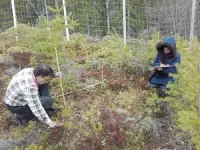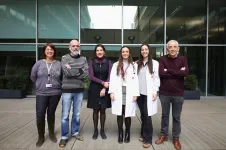(Press-News.org) CHAMPAIGN, Ill. — A new book from University of Illinois Urbana-Champaign anthropology professor Kathryn Clancy takes an unflinching look at the many ways humans have struggled – and often failed – to understand one of the greatest mysteries of human biology: menstruation.
In “Period: The Real Story of Menstruation,” Clancy first focuses on the myriad ways human societies, their leaders, scientists and health practitioners have gotten it wrong – from myths and taboos about the purpose and health effects of menstruation to the quasi-scientific studies purporting to demonstrate that menstruating people give off toxic fumes that can harm children or other humans.
The myths, taboos, bad science and extensive shaming of people who menstruate do real harm to those individuals. These failures also allow scientists and practitioners to deny their patients the intellectual rigor, care and understanding reserved for the rest of society, Clancy writes. The myths also self-perpetuate in fields like anthropology.
“Many older ethnographies and historical works describe menstrual taboos as phenomena, universal across cultures, aimed at protecting the community from the evils of menstruation,” she reports.
For example, anthropologists write about Chhaupadi in Nepal, a practice of forcing menstruating people “to stay in crude structures for the duration of menses,” Clancy writes. Girls in these locales are sometimes bitten by snakes, suffer from exposure to the elements or from smoke inhalation. The practice may instill a sense of shame, of not belonging fully to the larger community.
But other societies welcome and celebrate the onset of menarche, honoring it as rite of passage with profound implications for the future health of the community.
“Among the Hupa of Northern California, for example, menstruating people gather in women’s houses, called min’ch, which are also spaces used during the postpartum period and after a miscarriage,” Clancy writes. “Min’ch translates to ‘a small, familiar, or dear house.’” These are not places of isolation but of community.
The heart of the book focuses on the evolving, maturing science of menstruation – with concrete examples from Clancy’s and other people’s work – and the kinds of questions that can now be asked and answered with newer technologies.
Wide variation in menstrual – and by extension, reproductive – experiences is a key theme. This variation reflects how the many processes of the uterus, including the way it repeatedly rebuilds and remodels its endometrium, allow it respond to internal and external factors including diet, exercise, stress, hormonal status, sexual activity and even the quality of a sexual partner’s sperm, Clancy writes.
This contradicts the “hero myth” around sexual procreation that casts the sperm as the active, determining factor in a successful pregnancy, and the woman’s body as a passive vessel awaiting her “prince,” she writes.
Readers will learn about aspects of reproduction rarely if ever covered in basic reproductive biology classes. These include descriptions of follicular waves that allow the body to select the most robust eggs for potential fertilization, cervical crypts that selectively sequester sperm, uterine waves that control the speed of the sperm and contractions of the cervix that discourage sperm or other invaders from going up the reproductive tract.
The book also outlines the evidence supporting the idea that repeated menstrual cycles actually prepare the uterus for a healthy pregnancy.
Clancy describes the book as a feminist plea for a new, more inclusive, more thorough and celebratory take on women’s reproductive capacities and processes.
Clancy is an affiliate of the Beckman Institute for Advanced Science and Technology, the Carl R. Woese Institute for Genomic Biology and the Center for Social and Behavioral Science at the U. of I.
Editor’s notes:
To reach Kathryn Clancy, email kclancy@illinois.edu.
The book “Period: The Real Story of Menstruation” is available from Princeton University Press.
Reporters in the U.S. may request a review copy of the book by contacting Julia Haav at Julia_Haav@press.princeton.edu. Reporters in Europe may contact Kate Farquhar-Thomson at kate_farquhar-thomson@press.princeton.edu.
END
Researchers have discovered how a gene that increases the risk of developing genetic heart disease functions, paving the way for new treatments.
The study, led by Murdoch Children’s Research Institute and published in Nature Cardiovascular Research, has revealed a new pathway for how children and adults develop cardiomyopathy, a group of diseases that affect the heart’s ability to pump blood around the body.
Heart disease is the leading cause of death worldwide. Patients with cardiomyopathy, a form of heart disease ...
Researchers from Korea Advanced Institute of Science and Technology and University of Texas at Dallas published a new Journal of Marketing article that examines whether direct-to-consumer advertising for robotics surgery is effective at swaying patients to choose it over other types of procedures.
The study, forthcoming in the Journal of Marketing, is titled “The Role of Advertising in High-Tech Medical Procedures: Evidence from Robotic Surgeries” and is authored by Tae Jung Yoon and TI Tongil Kim.
Robotic surgery and the ethics ...
Taking vitamin D supplements may help ward off dementia, according to a new, large-scale study.
Researchers at the University of Calgary’s Hotchkiss Brain Institute in Canada and the University of Exeter in the UK explored the relationship between vitamin D supplementation and dementia in more than 12,388 participants of the US National Alzheimer's Coordinating Center, who had a mean age of 71 and were dementia-free when they signed up. Of the group, 37 per cent (4,637) took vitamin D supplements.
In the study, ...
Rounding checklists can help hospital care teams improve patient outcomes, and new research points to the potential for patient-specific checklists as a valid way to effectively translate the latest evidence into clinical practice.
These checklists can be helpful tools during daily rounds when multidisciplinary members of the patient care team convene to discuss each patient’s status and care plan. If too complex or generic, the checklists may instead become a burden, taking up valuable time with minimal impact.
One way to customize rounding checklists is to have an individual serve as a checklist prompter, listening to the conversation, eliminating ...
Research Highlights:
In a study of U.S. military veterans, researchers noted that participating in home-based cardiac rehabilitation was associated with a 36% lower risk of death compared to veterans who chose not to participate in cardiac rehabilitation.
Less than half of the study participants enrolled in rehabilitation, which focused on improving heart-healthy behaviors.
The research may be the first U.S. study to provide evidence of living longer with home-based cardiac rehabilitation in people with heart disease.
Embargoed until 4 a.m. CT/5 a.m. ET Wednesday, March 1, 2023
DALLAS, ...
Flamingos form cliques of like-minded individuals within their flocks, new research shows.
Scientists analysed the personalities and social behaviour of Caribbean and Chilean flamingos.
Birds of both species tended to spend time with others whose personality was similar to their own.
The study, by the University of Exeter and the Wildfowl & Wetlands Trust (WWT), reveals the complex nature of flamingo societies and could help in the management of captive flocks.
“Our previous research has shown that individual flamingos have particular ‘friends’ within the flock,” said Dr Paul Rose, from WWT and Exeter’s Centre for Research in Animal Behaviour.
“In ...
Toronto, ON — A new study published in the journal International Social Work has uncovered concerning rates of depression, post-traumatic stress disorder (PTSD) and anxiety among social workers.
Stressors related to COVID-19 were the strongest factors associated with the negative mental health outcomes. Those who experienced a higher number of pandemic-related stressors — such as health concerns, increased caregiving responsibilities, violence in the home, family stress due to confinement, and stress associated with work-life balance — experienced mental health problems ...
The mainly brown woodcock uses its bright white tail feathers to communicate in semi-darkness, reflecting 30% more light than any other known bird.
These surprise findings, by a team led by an Imperial College London scientist, suggest there is much to learn about how birds that are most active at night or at dawn and dusk communicate.
Birds that are most active during the day often have colourful plumages, which they use to communicate information with each other. Birds that are most active at dawn and dusk or at night (‘crepuscular’), such as nightjars and woodcocks, tend to have less showy plumage, as while sleeping during ...
Cells that form cutaneous squamous cell carcinoma tumours prepare themselves to migrate to the lymph nodes to metastasise other organs, and they make changes so that they can survive this process. According to a study led by researchers from the Inflammatory and Neoplastic Dermatological Diseases Research Group at the Hospital del Mar Medical Research Institute, published in the journal Life Science Alliance, these cells stop consuming glucose so that they can survive by using LDL cholesterol molecules, the ...
Although cable locks – commonly distributed to prevent firearm injury and death – are included in many legal firearm purchases, research shows firearm owners rarely prefer or use these devices.
But a Rutgers study published in Injury Epidemiology found that gun owners who were told about cable locks at the time they purchased the firearm were more than twice as likely to use locking devices than those who weren’t told about cable locks when they made these purchases.
“Simply placing a cable lock in a bag when somebody purchases a firearm likely has minimal impact, but a simple discussion mentioning that a lock was included may make enough of an ...






